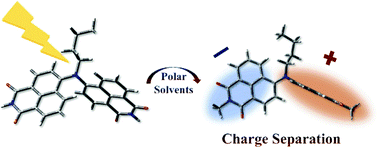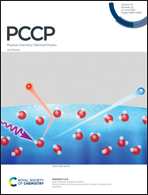Symmetry-breaking charge separation in a nitrogen-bridged naphthalene monoimide dimer†
Abstract
The photophysical properties of 4-aminonaphthalene-1,8-imide-based derivatives, bis-ANI, consisting of two naphthalimide (NI) units linked by a butylamine bridge and its monomer ANI have been intensively investigated by steady-state and transient spectroscopy combined with quantum chemical calculations. The excited state relaxation dynamics of the two molecules are studied in three solvents of varying polarity – from hexane to tetrahydrofuran to acetone. A strong reduction in the fluorescence quantum yields and larger red shifts of the emission spectra are observed when going from the monomer ANI to dimer bis-ANI with increasing solvent polarity. It is found that the presence of the central amino linker in bis-ANI facilitates the formation of an asymmetric CS state between the ANI and NI moieties in bis-ANI, where NI˙− is the dominant radical anion unit after CS, evidenced by the femtosecond transient absorption measurements and spectroelectrochemistry in polar solvents. Femtosecond transient absorption spectra and quantum chemical calculations reveal the conformational change after the formation of the symmetry-breaking charge separation (SBCS) state upon photoexcitation, while a near-orthogonal structure in the excited state of bis-ANI retards charge recombination. In addition, it is evidenced that the rate of SBCS can be tuned by changing the different polar solvents.



 Please wait while we load your content...
Please wait while we load your content...